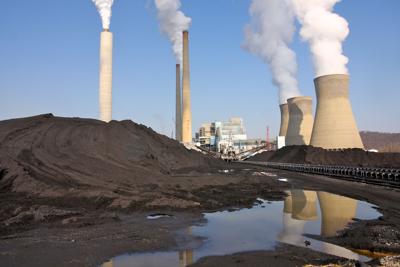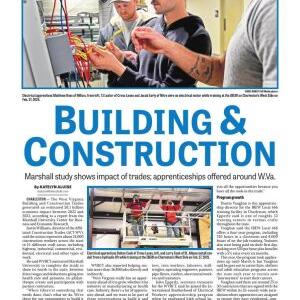‗‗‗¢╩ËãÁ coal piles up at coal plants, cost liabilities mount for electric ratepayers.
Appalachian Power and Wheeling Power have announced a $71.6 million fuel cost rate increase effective Sept. 1 following what the American Electric Power subsidiaries reported were losses of $40.5 million they incurred as they burned coal to address coal oversupply at their plants.
The utilities have asked the West Virginia Public Service Commission to approve a 3.79% climb in total revenues to cover their rate hike request. They have proposed average monthly increases of $5.31 (3.03%) for residential customers, $15.05 (3.31%) for commercial customers and $13,400 (4.77%) for industrial customers.
The Appalachian Power and Wheeling Power rate hike request follows years of scrutiny of their fuel procurement practices from consumer advocates, who are now also challenging a proposal by the companies to recover roughly $2.4 billion of costs through consumer rate relief bonds.
Renewable energy proponents point to evidence the utilities‗‗‗¢╩ËãÁÖ persistent reliance on coal-fired electricity is imposing too steep a cost on West Virginia ratepayers as coal becomes an increasingly uneconomic power source.
‗‗‗¢╩ËãÁ£At utilities, the huge stockpiles are not just a storage headache. They‗‗‗¢╩ËãÁÖre a financial headache, too,‗‗‗¢╩ËãÁØ the Institute for Energy Economics and Financial Analysis, a Valley City, Ohio-based energy market analysis firm, said in a December 2024 report on U.S. power producers‗‗‗¢╩ËãÁÖ coal oversupply.
Tens of millions of dollars in APCO, WPCo coal plant losses
Low electric energy prices in 2024 resulted in a ‗‗‗¢╩ËãÁ£lower economic dispatch‗‗‗¢╩ËãÁØ of Appalachian Power and Wheeling Power coal-fired generating units in line with regional averages, resulting in coal supply that exceeded market demand for coal-fired power in 2024 and the companies‗‗‗¢╩ËãÁÖ consumption, American Electric Power Service Corp. regulatory services director Jason Stegall testified in utility testimony filed with the PSC on April 29.
That imbalance put Appalachian Power and Wheeling Power at risk for exceeding storage limits at their coal-fired plants, Stegall said, noting that when the companies reach maximum storage level, they can‗‗‗¢╩ËãÁÖt accept further deliveries and risk having to pay for coal they can‗‗‗¢╩ËãÁÖt receive.
One way the utilities address that risk is by using market strategies to increase coal consumption, Stegall testified. Those strategies, Stegall said, include a ‗‗‗¢╩ËãÁ£Must Run‗‗‗¢╩ËãÁØ status for coal plant units, meaning the companies commit them into the energy market for regional grid operator PJM and run them at ‗‗‗¢╩ËãÁ£economic minimum output‗‗‗¢╩ËãÁØ to increase generation and thus raise coal consumption and lower risk of exceeding maximum coal storage levels.
When ‗‗‗¢╩ËãÁ£Must Run‗‗‗¢╩ËãÁØ status didn‗‗‗¢╩ËãÁÖt yield a level of coal consumption that addressed the companies‗‗‗¢╩ËãÁÖ concerns, they used a price decrement to ensure PJM dispatched their units at levels that did, Stegall indicated.
The companies incurred losses of $40.5 million, Stegall said, asserting those losses were far below $299.8 million they could have lost had they violated their coal contracts and been forced to pay for coal which they couldn‗‗‗¢╩ËãÁÖt accept.
The biggest single-unit loss among Appalachian Power and Wheeling Power coal-fired units totaled $15.3 million at the one unit at the former‗‗‗¢╩ËãÁÖs Mountaineer plant in Mason County, according to Stegall‗‗‗¢╩ËãÁÖs testimony. The two units at the latter‗‗‗¢╩ËãÁÖs Mitchell plant in Marshall County combined to lose $24.2 million, per Stegall.
‗‗‗¢╩ËãÁ£The Companies have demonstrated reasonable and prudent actions to procure economic fuel for their plants,‗‗‗¢╩ËãÁØ Appalachian Power regulatory services director Randall Short said in written testimony filed with the PSC.
PSC, court found APCo, WPCo botched fuel oversight
In January 2024, the PSC issued an order disallowing Appalachian Power and Wheeling Power from recovering $231.8 million in fuel costs from ratepayers after finding they failed to manage their coal-fired power plant operations prudently.
The PSC found the companies had disregarded trends and market signals impacting their coal procurement, causing them to over-rely on power purchased from PJM‗‗‗¢╩ËãÁÖs wholesale electricity market rather than generating energy at their own West Virginia plants.
But the West Virginia Supreme Court of Appeals in November 2024 filed an opinion reversing the PSC order, finding it was based on ‗‗‗¢╩ËãÁ£extra-record evidence‗‗‗¢╩ËãÁØ of which the utilities weren‗‗‗¢╩ËãÁÖt given notice.
The companies had appealed the PSC order, which had allowed the rest of their requested cost recovery ‗‗‗¢╩ËãÁö $321.1 million ‗‗‗¢╩ËãÁö to be assessed to customers through a fuel cost rate hike starting Sept. 1, 2024.
In an opinion authored by Justice John Hutchison, the court agreed with the PSC that the utilities didn‗‗‗¢╩ËãÁÖt manage their coal-fired power plant operations prudently.
But the court sided with the companies in finding it was ‗‗‗¢╩ËãÁ£fundamentally unfair‗‗‗¢╩ËãÁØ for the PSC to consult and rely on information outside the evidentiary record in the case in arriving at its disallowance calculation.
In January, the PSC scheduled an evidentiary hearing in that case for Oct. 1-2 after the court sent the matter back to the PSC for further proceedings to allow the companies to address evidence on quantifying fuel costs.
The PSC‗‗‗¢╩ËãÁÖs rejected ruling had referenced a report it commissioned from Critical Technological Consulting, a Mesa, Arizona-based, power industry-focused consulting firm, that found the agency should disallow over $200 million in cost under-recovery.
CTC‗‗‗¢╩ËãÁÖs observation that Appalachian Power and Wheeling Power should have burned more coal at their power plants aligned with a PSC requirement that the companies, renewable energy experts and Virginia utility regulator staff have deemed uneconomic.
‗‗‗¢╩ËãÁÿMoney idly sitting around‗‗‗¢╩ËãÁÖ
Coal stockpiles at U.S. electric power plants reached their highest total at the end of May last year since the first half of 2020, when the COVID-19 pandemic reduced electricity demand and coal consumption, according to the U.S. Energy Information Administration.
U.S. coal power plants generally stockpile much more coal than they consume in a month, and the EIA reported in August 2024 more than 90% of coal-fired power plants had enough coal on hand to generate electricity for 60 days or more.
The Institute for Energy Economics and Financial Analysis estimated U.S. utility coal stockpiles could represent as much as $6.5 billion in unused inventory.
‗‗‗¢╩ËãÁ£No power producer wants that much money idly sitting around,‗‗‗¢╩ËãÁØ said the IEEFA‗‗‗¢╩ËãÁÖs report authored by energy analysts Seth Feaster and Dennis Wamsted. ‗‗‗¢╩ËãÁ£But it has become much harder to burn that coal without losing money.‗‗‗¢╩ËãÁØ
Low gas prices and increased solar and wind generation have made coal-fired electricity progressively less competitive, the authors noted.
The EIA projects U.S. coal production to decline another 6.1% from 2025 to 2026 as more power comes online from more competitive energy sources, meaning a persistent threat of a ‗‗‗¢╩ËãÁ£mountain of coal‗‗‗¢╩ËãÁØ at plants via deeper production cuts.
Multibillion-dollar securitization proposal panned
Appalachian Power and Wheeling Power in March filed a request with the PSC to recover roughly $2.4 billion of costs through consumer rate relief bonds, asserting it would lessen the rate impact on customers proposed in a base rate request pending from November 2024 to increase their annual revenues by $250.5 million, raising rates in West Virginia by 14.1%.
A residential customer using 1,000 kilowatt-hours per month would see a net increase in their monthly bill of roughly 13.5%, or $23.74, under the companies‗‗‗¢╩ËãÁÖ traditional proposal calling for the $250.5 million revenue hike. But the companies estimated recovering costs through consumer rate relief bonds, a process called securitization, would yield a shorter monthly bill climb of 3.8% ‗‗‗¢╩ËãÁö or $6.72 ‗‗‗¢╩ËãÁö for a residential customer using 1,000 kilowatt-hours.
Without securitization, average monthly bills would increase $27.15 (16.2%) for residential customers, $57.09 (14%) for commercial customers and $32,385 (11.6%) for industrial customers, the companies estimated.
But in testimony filed Tuesday, witnesses for PSC staff and the agency‗‗‗¢╩ËãÁÖs Consumer Advocate Division, which is charged with representing residential ratepayer interests, separately questioned the utilities‗‗‗¢╩ËãÁÖ securitization proposal.
Consumer Advocate Division witness Ralph Smith ‗‗‗¢╩ËãÁö a consultant at Livonia, Michigan-based certified public accounting and regulatory consulting firm Larkin & ‗‗‗¢╩ËãÁsociates PLLC ‗‗‗¢╩ËãÁö testified that securitization, ‗‗‗¢╩ËãÁ£particularly if rushed through,‗‗‗¢╩ËãÁØ can harm utility ratepayers by saddling them with higher financing costs and a long-term burden of charges that would be difficult to change.
Smith contended the companies‗‗‗¢╩ËãÁÖ securitization proposal included:
- An unreliable analysis of whether the investment will be profitable
- A significantly increased securitization financing cost rate for deferrals for which ratepayer-borne financing costs already have been subject to mitigation
- Potential for substantially increased total costs to the companies‗‗‗¢╩ËãÁÖ ratepayers
Smith testified that if the companies‗‗‗¢╩ËãÁÖ proposed $2.4 billion securitization is approved, the estimated total cost to West Virginia ratepayers could be just shy of $4 billion, basing his estimate on information supplied by the companies.
‗‗‗¢╩ËãÁ£[G]iven the size and impact at stake, the importance to West Virginia ratepayers of having a thorough, detailed review and vetting of the Companies‗‗‗¢╩ËãÁÖ securitization proposal cannot be over-emphasized,‗‗‗¢╩ËãÁØ Smith said in his written testimony.
PSC staff utilities analyst Geoffery Cooke testified ratepayers would pay 45.3% more if fuel cost deferral and deferred storm expenses are securitized as planned compared with what the PSC has approved or what was proposed in the companies‗‗‗¢╩ËãÁÖ base rate proceeding.
Controversial net metering change proposed
That base rate proposal elicited 3,700 comments in opposition and no comments in support as of Wednesday, according to PSC data.
The average monthly residential utility cost for Appalachian Power and Wheeling Power for 1,000 kilowatt-hours rose from $55.28 in 2005 to $169.69 in 2024, per PSC data ‗‗‗¢╩ËãÁö a 207% increase.
The rate hike plan has drawn especially strong ire from proponents of an arrangement that can lower dependence on coal by incentivizing use of solar power.
That arrangement is net metering, in which a residential customer owns or leases and operates an energy resource, often solar, connected on their side of the utility meter.
Supporters of net metering say it cuts back on straining distribution systems and encourages economic and environmental benefits through customers lowering future electric bills by exporting power to the grid.
But the companies asserted in their base rate hike proposal their current net metering setup shifts cost responsibility onto nonparticipating customers. They have proposed a new net metering compensation structure in which new net metering customers would no longer be credited the full retail rate for the metered energy they produce and deliver to the utility electric system.
Dan Conant, founder and president of Huntington-based solar developer Solar Holler LLC filed testimony against the proposal, saying it would halt new residential and commercial solar projects and harm West Virginia‗‗‗¢╩ËãÁÖs economy.
Testifying on behalf of West Virginia Citizen Action Group, Solar United Neighbors and Energy Efficient West Virginia, Justin Barnes, president of Cary, North Carolina-based energy consulting firm EQ Research LLC, recommended rejecting the companies‗‗‗¢╩ËãÁÖ proposal, saying it is ‗‗‗¢╩ËãÁ£entirely inconsistent with cost-based ratemaking.‗‗‗¢╩ËãÁØ
An evidentiary hearing in that case is scheduled for June 17-19. The PSC scheduled a public comment hearing for 5:30 p.m. June 17 to be held virtually and in person at the PSC‗‗‗¢╩ËãÁÖs 201 Brooks St. headquarters in Charleston.
In the meantime and beyond, the Mountain State‗‗‗¢╩ËãÁÖs AEP utilities and power producers throughout the country will look to avoid growing mountains of coal.
‗‗‗¢╩ËãÁ£[T]he longer that mountain of coal persists,‗‗‗¢╩ËãÁØ the IEEFA report predicted, ‗‗‗¢╩ËãÁ£the deeper the delivery cuts and ultimately production cuts will have to be.‗‗‗¢╩ËãÁØ















